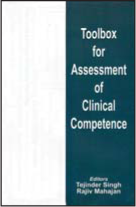Translate this page into:
Book Reviews: Toolbox for Assessment of Clinical Competence. Principles of Medical Education
[To cite: Sachdeva A. Toolbox for assessment of clinical competence (Book Review). Natl Med J India 2024:37:55. DOI: 10.25259/NMJI_121_2024]
Toolbox for Assessment of Clinical Competence. Principles of Medical Education. First edition. Tejinder Singh, Rajiv Mahajan (eds). Unistar Books Pvt. Ltd. 124pp, ₹250. ISBN 978–93– 5816–013–0.

This book is a compendium of different tools available for measuring clinical competence. Medical teachers involved in assessment need to know not only about the tools available for assessment but also which tool to select for which specific context. Assessing clinical competence in medical education is crucial to ensure that healthcare professionals are well-prepared and capable of delivering quality patient care. The editors have tried to move away from the concept of ‘One best tool’ to a multitude of tools for assessment of clinical competence.
In the past decade, medical education has been evolving with the integration of various new tools and technologies to enhance the assessment of authentic medical practices. Assessment has a strong steering effect on learning and the curriculum. It depicts what medical teachers value as important and acts as the most cogent motivator of student learning. While a medical teacher plans and designs assessments, it is essential to recognize the stakes involved in it. The higher the stake, the greater the implications of the outcome of the assessment. The more sophisticated the assessment strategies, the more appropriate they become for feedback and learning. Two important principles determine the benefits that can be accrued from any tool used for assessment. First, the context in which the tool is used and second, the feasibility aspects.
The present manual starts with the principles of assessment, assessment planning and then elaborates on different tools available as separate sub-sections; namely assessment tools for ‘Knows and knows how, i.e. essay questions, case vignettes, spotting etc.’, assessment tools for ‘Shows, i.e. cases, objective structured practical or objective structure clinical examination, patient encounters, logbooks and portfolios, etc.’, and finally assessment tools for ‘Does, i.e. mini clinical evaluation exercise, direct observation of procedural skills, clinical encounter cards, epilogue, etc.’ Each chapter is structured and presented as a brief description of the tool in context, what it tests and finally the pros, the cons and the innovations available. The writing style helps better understanding of the topics.
The strengths include listing of a variety of assessment tools for assessing clinical competence, highlighting the importance of using a combination of tools to gain comprehensive understanding. A striking feature of this book is that it is written from the perspective of a medical teacher and covers the different assessment methods. Further reading will be required nonetheless by medical teachers for comprehensive understanding of the topic and the list of important references in each chapter is a ‘ready to refer to’ list. Overall, it is indeed an excellent resource with simple succinct ideas. The quality of production and the legibility of the typeface are very good.
This book has the potential to serve as a supplement to a medical teacher who wishes to design an effective assessment strategy. Ultimately, an effective assessment strategy often involves using a combination of these tools to gain comprehensive understanding of a learner’s clinical competence. It is important to note that the landscape of medical education is dynamic, and new tools and methodologies continue to emerge. The key is to balance the strengths and weaknesses of each method to create a robust and fair evaluation process.




